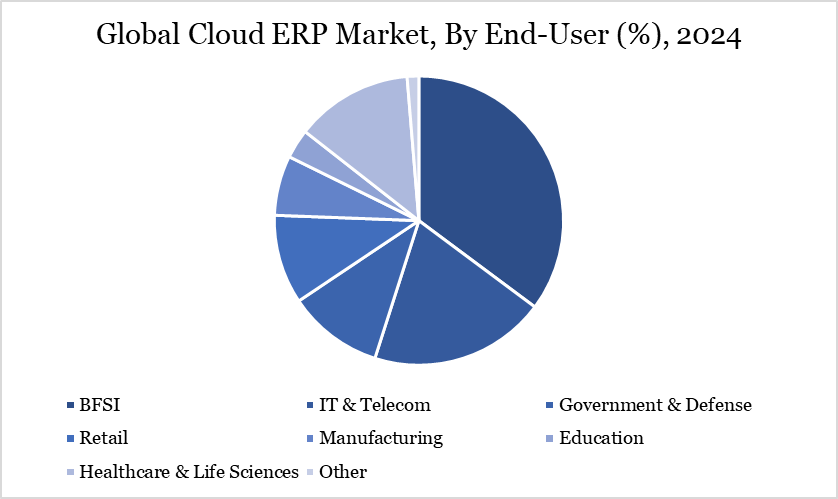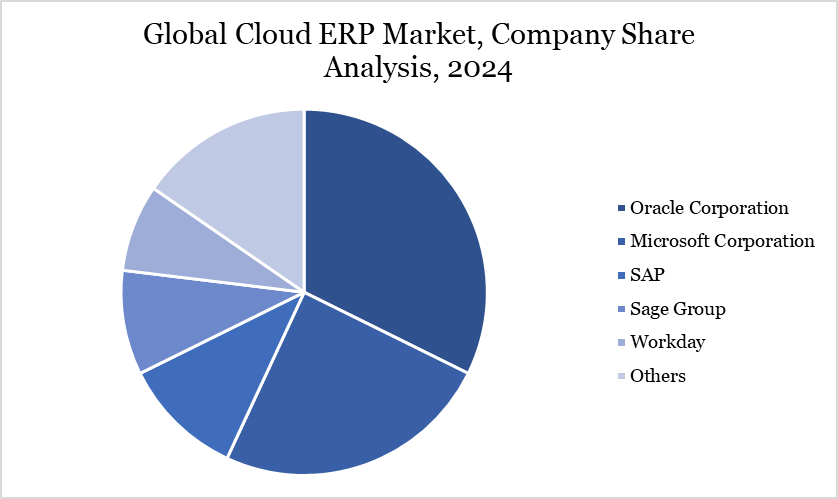Cloud ERP Market Size
Cloud ERP Market reached US$ 48.63 billion in 2024 and is expected to reach US$ 176.93 billion by 2032, growing with a CAGR of 17.52% during the forecast period 2025-2032.
The increasing need for advanced ERP solutions with high-end analytics capabilities to identify possible issues like delays and disruptions and the swift adoption of artificial intelligence (AI) and machine learning (ML) technologies in the creation of cloud-based enterprise resource planning (ERP) solutions, are identified as key drivers of market growth.
The industry is witnessing an increase in demand for small and medium enterprises. Small and medium-sized enterprises utilize ERP solutions to facilitate departmental coordination and cooperation as well as enhance corporate processes through openness. It can integrate their financial and consumer data into one system. In March 2023, SAP SE launched a cloud ERP solution for medium-sized organizations to facilitate improved business administration and manage issues in uncertain markets.
Cloud ERP Market Trend
One of the major trends in the international cloud ERP market is growing construction adoption. Cloud ERP solutions facilitate construction companies to more effectively manage project expenses by tying financial information to project activities. For instance, in May 2023, NCC, a builder, partnered with IFS, a provider of cloud software, to enhance productivity and efficiency across all its activities in the four Nordic nations.
IFS Cloud will replace NCC's current Infor Lawson ERP and IBM Maximo EAM solutions. The solution will enhance NCC's company visibility, elevate operational efficiency and streamline accounting processes. NCC Company will utilize IFS Cloud Enterprise Asset Management (EAM) as part of the partnership, while IFS Cloud ERP will serve 7,000 NCC users.

For more details on this report – Request for Sample
Market Scope
| Metrics | Details |
| By Component | Solutions, Services |
| By Business Function | Finance & Accounting, Order & Procurement, Sales & Marketing, Operations, Human Resources, Enterprises Performance, Others |
| By Organization Size | Large Enterprises, SMEs |
| By Deployment Mode | Public Cloud, Private Cloud, Hybrid Cloud |
| By End-User | BFSI, IT & Telecom, Government & Defense, Retail, Manufacturing, Education, Healthcare & Life Sciences, Other |
| By Region | North America, South America, Europe, Asia-Pacific, Middle East and Africa |
| Report Insights Covered | Competitive Landscape Analysis, Company Profile Analysis, Market Size, Share, Growth |
Cloud ERP Market Dynamics
Rising Adoption of Generative AI
Generative AI (GenAI) is transforming workplace dynamics and interactions significantly by substantially enhancing efficiency and streamlining business operations. By combining GenAI with cloud ERP, companies can improve operational efficiency, re-engineer decision-making processes, implement predictive algorithms and enhance automation and data analysis.
The cutting-edge technology improves organizational flexibility through process efficiencies and real-time facts. Further, the use of AI for cloud ERP solutions allows companies to extend critical operations, allowing continuous learning and adaptation for better performance. In October 2023, Deloitte boosted the SAP Business Technology Platform (SAP BTP) to offer GenAI solutions to ERP customers.
Additionally, in February 2024, Kyndryl strengthened its partnership with Google Cloud to accelerate the development of GenAI and Responsible AI. The partnership enabled Kyndryl to leverage the Google Cloud Cortex Framework to improve the value of ERP data on Google Cloud.
Limited Customization Options
Cloud-based ERP systems offer a number of advantages, such as scalability, cost-saving and accessibility, but they often carry the drawback of imposing restrictions on tailoring the software to meet the specific needs of particular enterprises. SaaS ERP solutions are designed to be widely standardized and flexible and aim at a broad range of industries and companies. As a result, they can lack enough flexibility and responsiveness to suit the requirements of particular companies.
Businesses across various industries often have unique and complex processes that distinguish them from their competitors. SaaS ERP solutions, with their standardized nature, might not accommodate custom workflows, requiring businesses to adapt current processes to fit the software, resulting in inefficiencies. SaaS ERP systems offer some customisation, albeit typically less restrictive than is the case with on-premises ERP solutions. The users can find it difficult to completely modify the program in order to accurately fit their own company requirements.
Cloud ERP Market Segment Analysis
The global cloud ERP market is segmented based on component, business function, organization size, deployment mode, end-user and region.

ERP Innovations and Strategic Partnerships Drives IT & Telecomm Growth
The introduction of 5G technology has created new opportunities for the IT and telecom industries. Cloud ERP vendors have started focusing on integrating features of handling and optimizing 5G network resources, thus ensuring proper delivery of services and improving customer experience, which is expected to drive market growth.
In September 2022, network software vendor Mavenir disclosed the integration of Google Cloud's public cloud infrastructure with cloud-native 5G solutions. The partnership between Mavenir and Google Cloud will enable Communications Service Providers (CSPs) to leverage Google Cloud's cloud-scalable infrastructure, enhanced data analytics features, container deployment and management platforms and 5G apps and solutions. It simplifies and lowers CSPs' costs by moving segments of traditional telecom application operations into the cloud, while not sacrificing network management, performance or insights.
Cloud ERP Market Geographical Share
Expanding E-Commerce Drives Cloud ERP Growth and Adoption in Asia-Pacific
Asia-Pacific has witnessed rapid digital adoption and e-commerce growth, with countries such as China, India and Japan showing significant advancements in cloud ERP adoption. The technologies include cloud-native architecture, metadata-driven multi-tenant architecture and real-time intelligence. Such developments are expected to boost market growth in the region.
For example, in April 2023, Huawei, a manufacturing company, publicly declared the replacement of its old ERP system with its totally controlled MetaERP system. MetaERP is used to manage 80% of Huawei's business activities and all business backgrounds. In addition, Huawei cooperated with partners in integrating innovative technologies into the MetaERP system, markedly improving service efficiency and operation quality.
Chinese businesses are looking to make their operations more modernized and global in nature, often choosing Cloud ERP solutions as an affordable yet scalable method for achieving this goal. Additionally, as businesses expand, they require ERP systems that govern complex operations in multiple regions and comply with varying regulatory practices. The expansion of businesses into emerging local marketplaces increases the use of Cloud ERP solutions.
Sustainability Analysis
Cloud ERP systems are integrated with functionalities that allow businesses to track and oversee their environmental footprint. Cloud ERP systems can measure carbon emissions, audit the sustainability performance of vendors and project the environmental effects of business decisions. By integrating sustainability metrics into fundamental business processes, cloud ERP allows companies to align business operations with environmental agendas and regulatory compliance.
As companies around the globe seek to reconcile development with ecological responsibility, cloud ERP becomes a central instrument for the realization of sustainability goals. Through the easing of processes and the minimization of ecological signatures, cloud ERP becomes a strategic resource within the worldwide shift toward sustainable business.
Cloud ERP Market Major Players
The major global players in the market include Oracle Corporation, Microsoft Corporation, SAP, Workday, Infor, IFS, Plex Systems, Epicor Software Corporation, Sage Group and Ramco Systems.

Key Developments
In 2024, Microsoft and Adobe planned to bring Adobe Experience Cloud workflows and analytics into Microsoft Copilot. The partnership will utilize Microsoft 365 to enable marketers to overcome data and application barriers and enhance daily workflow management.
Why Choose DataM?
Data-Driven Insights: Dive into detailed analyses with granular insights such as pricing, market shares and value chain evaluations, enriched by interviews with industry leaders and disruptors.
Post-Purchase Support and Expert Analyst Consultations: As a valued client, gain direct access to our expert analysts for personalized advice and strategic guidance, tailored to your specific needs and challenges.
White Papers and Case Studies: Benefit quarterly from our in-depth studies related to your purchased titles, tailored to refine your operational and marketing strategies for maximum impact.
Annual Updates on Purchased Reports: As an existing customer, enjoy the privilege of annual updates to your reports, ensuring you stay abreast of the latest market insights and technological advancements. Terms and conditions apply.
Specialized Focus on Emerging Markets: DataM differentiates itself by delivering in-depth, specialized insights specifically for emerging markets, rather than offering generalized geographic overviews. This approach equips our clients with a nuanced understanding and actionable intelligence that are essential for navigating and succeeding in high-growth regions.
Value of DataM Reports: Our reports offer specialized insights tailored to the latest trends and specific business inquiries. This personalized approach provides a deeper, strategic perspective, ensuring you receive the precise information necessary to make informed decisions. These insights complement and go beyond what is typically available in generic databases.
Target Audience 2024
Manufacturers/ Buyers
Industry Investors/Investment Bankers
Research Professionals
Emerging Companies